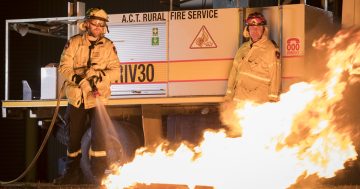
Libraries, shopping centres and community centres can be alternative refuges for people looking to escape the heat. Photo: ACT Government.
A new mechanism to allow Canberra’s clubs to become heat refuges isn’t likely to be triggered during the ACT’s current sweltering week of heat.
Earlier this year, the ACT Government established a framework for clubs to be available as refuges during emergencies or other hazards, such as extreme heat or smoke.
Libraries, community centres and shopping centres are suggested as alternatives to escape the heat during the day.
Despite a severe heatwave warning being issued for the Territory by the Bureau of Meteorology, looming storm clouds have delayed this trigger being pulled.
Gaming Minister Shane Rattenbury explained that the legislation allowed him to issue a club refuge declaration but that he had to take into account the advice of the ACT Emergency Services Agency (ESA) Commissioner first.
“If the Emergency Services commissioner declares an emergency, such as a bushfire or heatwave, then [I] would consider declaring suitable clubs as refuges, consistent with the Commissioner’s advice,” he said.
In turn, the ACT ESA Commissioner follows advice from the ACT Ambulance Service chief officer, who has not enacted the service’s heatwave plan at this stage.
However, it appears the club refuge program wouldn’t be available for the community to access even if the emergency threshold was reached.
Mr Rattenbury confirmed the Justice and Community Safety Directorate (JACS) had only received one expression of interest from a club, which operates several venues across Canberra, to be part of the program.
“[JACS] is in the process of assessing the suitability of these venues for use as a refuge,” he said.
“The government hopes and expects that further clubs will participate in this program to provide this important community service.”
The Bureau of Meteorology (BoM) uses the ‘excess heat factor’ when monitoring and forecasting heatwaves, classifying them by intensity.
This combines a comparison of average temperatures for a three-day period that “would be considered hot at that location” and the observed temperatures at the location over the past month.
“In simple terms, the EHF measures how much of a shock to the body the forecast temperatures will be, compared to the weather over the past month,” according to a BoM explainer on heatwaves.
“The calculation allows for people’s ability to adapt to heat. For example, the same temperature feels different to residents of Perth and Hobart. A 35-degree day will feel warmer to people who live in Hobart as they are used to cooler temperatures.”
Severe heatwaves are less frequent during summer and are likely to be more challenging for vulnerable people.

Severe heatwave conditions are expected to peak on Saturday (9 December). Photo: BoM.
Temperatures across the Territory are expected to increase to the mid to high 30s over the weekend, with minimums climbing to the low 20s.
The severe heatwave conditions are expected to peak on Saturday (9 December) before a cool change moves through.
However, temperatures are expected to climb again next week.





















